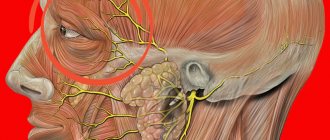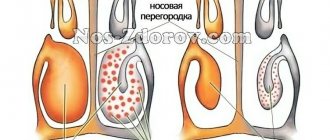What you need to know
Bleeding of various localizations often serves as a reason to seek emergency medical help.
The causes of bleeding can be different. From a simple injury to more serious health problems. It is not always possible to establish the cause of bleeding if it is not known about any chronic disease that caused this condition. Then they limit themselves to clarifying the location and severity of bleeding, taking local pre-medical measures to stop bleeding and combat the consequences of blood loss. Each of us has experienced a nosebleed at least once in our lives, either ourselves or someone around us. The situation is simple, but its health consequences can be quite serious and even dangerous. Let's figure out together what nosebleeds are, what their causes and possible consequences are, and also consider the rules for providing emergency care for nosebleeds.
Among spontaneous bleeding from the upper respiratory tract, nosebleeds are in first place in frequency. The nasal membrane is rich in blood vessels, which determine the frequency of nosebleeds in different categories of people.
However, not all bleeding from the external openings of the nose indicates epistaxis. The latter can often be bleeding from the deeper respiratory tract, as well as from the esophagus or stomach.
In children or debilitated patients, bleeding may go unnoticed if the blood flows into the throat. In such cases, vomiting blood or coughing up blood is often the first sign of a nosebleed.
Also, all nosebleeds can be divided according to the degree of localization:
- Anterior , accounting for almost 90% of all nosebleeds. Localized in the anterior part of the nasal septum. The mucous membrane in this place is thin, without a submucosal layer, rich in a network of capillary vessels. Such bleeding is not life-threatening, does not last long, and is easily stopped.
- Posterior , caused by damage to larger vessels. Lead to significant blood loss and can be life threatening.
By severity:
- Minor;
- Light (up to 500 ml). There is noticeable weakness and pallor. Tachycardia up to 100. Skin is warm. You may experience flickering of flies before your eyes.
- Medium (20% blood). Marked weakness. Shortness of breath appears. Blood pressure drops. The skin is cool and moist.
- Heavy (more than 20% blood). Hemorrhagic shock. Thready pulse.
What are the types of nosebleeds?
Front
This type accounts for approximately 90% of all cases. Its source is the Kisselbach zone. It is located in front of the nasal septum. It is a large plexus of blood vessels lying in close proximity to the surface of the mucosa.
It is this zone that plays the role of a kind of barrier that warms the inhaled air and also disinfects it, trapping microorganisms and dust particles.
Bleeding from this area most often easily stops without additional medical procedures. This is facilitated by easy access to the vessels themselves, which can be tamponed independently.
Blood from one nostril may indicate unilateral damage to the mucous membrane. If you experience frequent bleeding from the right or left nostril, you should consult an ENT specialist. This specialist will help restore the normal state of the respiratory tract.
Rear
A type of bleeding, the source of which is the large branches of the arteries passing in the posterior sections of the nasal cavity. Most often, profuse bleeding is observed, which is very difficult to stop without additional medical procedures.
Front and back bleeding
This pathology is common mainly in old age, its basis is hypertension. Inaccessibility of blood vessels can lead to serious blood loss. If you cannot stop the bleeding on your own, be sure to immediately seek help from a specialist.
Causes
Local
- Traumatic injuries to the nose. They occupy first place among all causes of bleeding. Minor injuries include scratches, abrasions, damage to the nasal membrane by the patient's fingers when removing crusts, as well as injuries during sports or other activities.
- Acute and chronic runny nose. Nosebleeds are a frequent companion to chronic sinusitis, rhinitis, and adenoids. May occur when the nasal septum is deviated.
- Foreign bodies in the nasal cavity and sinuses. When a foreign body is introduced, the nasal mucosa is damaged, causing light bleeding. Bleeding can also occur after a long stay of a foreign body in the nasal cavity, with the formation of granulations.
- Surgical interventions.
- Bleeding due to ulcerations in the nasal cavity. Sometimes observed in chrome production workers or in people working with strong acids.
- Infiltrates of the nasal mucosa of a tuberculous or syphilitic nature can cause slight ichorous discharge.
- Benign or malignant neoplasms. Of the benign tumors, the most common cause is a bleeding polyp of the nasal septum, as well as papillomas, lymphomas, and angiomas. Bleeding from angiofibromas of the nasopharynx (often in men aged 13-26 years) should be considered serious. The first sign of this disease is frequent night bleeding.
Are common
- Cardiovascular diseases (hypertension, atherosclerosis, heart defects).
- Infectious diseases (typhoid fever, influenza, scarlet fever, malaria, as well as whooping cough during a severe cough).
- Hormonal imbalance. Observed in teenage girls with menstrual irregularities. Often found in amenorrhea and hypomenstrual syndrome.
- Diseases associated with stagnation in the circulatory system (emphysema, liver and kidney diseases, as well as pregnancy).
- Hemorrhagic diathesis (hemophilia, vasculitis, Werlhof's disease, thrombasthenia).
- Diseases of the hematopoietic organs (leukemia, hemocytoblastosis).
- Bleeding as a result of changes in atmospheric pressure while in the mountains, deep under water.
- Uncontrolled use of anticoagulants.
- Heatstroke or sunstroke
Causes and types of nosebleeds
There are two main types of causes that can cause nosebleeds:
- External.
- Internal.
External causes are associated with the influence of both the person himself and certain environmental factors.
Children and adolescents are especially susceptible to them:
| External reason | Description |
| Injuries | Damage to nasal vessels as a consequence of a blow. Sometimes the injury can be serious, with a fractured nasal septum and heavy bleeding. Young children also have the habit of picking their nose or sticking certain objects into it. This can also cause blood vessels to rupture. |
| Overwork, physical and emotional stress | Causes single, harmless bleeding. If the situation does not repeat itself, there will not be a second incident. |
| Sunstroke | Heat causes blood vessels to dry out and become brittle, which is why nosebleeds are a common occurrence in summer. It is not recommended for people with weak blood vessels to be in the sun without at least a Panama hat or a cap. |
| Frostbite, dry air | This also causes the nasal mucosa to dry out and cause fragile blood vessels to burst. |
Internal causes that cause nosebleeds are usually associated with certain pathological phenomena:
| Internal reason | Description |
| Increased pressure, both arterial and intracranial (hypertension) | Bleeding in this case is a good thing, since the blood, splashing out from the burst vessels, reduces the pressure and thus reduces the likelihood of a stroke. They usually occur between 4 and 6 am. |
| Inflammation of the mucous membranes and sinuses | The walls of blood vessels are weakened by the disease. |
| Papillomas/Polyps | Formations on the nasal mucosa that interfere with breathing and are signs of a viral disease. Causes regular morning bleeding. |
| Atherosclerotic changes | Loss of elasticity and strength in blood vessels. Often characteristic of older people. |
| Adrenal tumors | Causes an increase in hormones and frequent heavy bleeding. |
| Oncology | Causes frequent heavy bleeding. Other signs: the appearance of small ulcers, changes in the shape of the nose |
| Vitamin C deficiency | The vitamin strengthens the walls of blood vessels. Its deficiency causes frequent bleeding. |
In addition, nosebleeds may occur regularly due to certain types of medications and clotting problems. When a girl's nose bleeds, the reasons may also be related to pregnancy. Such a deviation, as a rule, requires serious treatment, although it is not always dangerous.
Bleeding is classified as follows:
| Type | Blood volume | Description |
| Minor | Several ml | It is harmless and has no consequences. Often characteristic of young children. |
| Moderate | 200 ml | Causes mild weakness and pallor, possibly dizziness |
| Massive | 300 ml | Severe weakness, dizziness and headaches, thirst |
| Profuse | 500 ml or more | Hemorrhagic shock: a sharp decrease in pressure, lethargy, loss of consciousness, lack of blood circulation. |
Massive and profuse nosebleeds, as well as bleeding in women who are carrying a child, require immediate medical attention.
Symptoms
Stopping nosebleeds
In some cases, nosebleeds can begin suddenly, against the background of complete health, sometimes even during sleep; in other cases, patients note increasing symptoms: headache, tinnitus, weakness, dizziness, weakness. The blood from nosebleeds is clear and bright red. If bleeding was preceded by a head injury, and blood flows from the nasal cavity in a yellowish color, you should urgently consult a doctor, as this may indicate a fracture of the base of the skull. Sometimes the bleeding can stop spontaneously, but sometimes it can continue for a long time, causing a drop in pulse rate and fainting.
Some bleeding may go unnoticed due to blood draining down the back of the throat. Such bleeding is mainly typical for children or bedridden patients. Increasing pallor, weak rapid pulse, and bloody vomiting indicate the presence of such bleeding.
The diagnosis does not present any particular difficulties. It is more difficult to determine the source of bleeding. In cases where it is not possible to detect a bleeding area in the nasal cavity, it is necessary to find out whether this bleeding is nasal bleeding, or indicates deeper lesions of other organs or systems.
Treatment of nosebleeds in adults and children consists of various methods of stopping existing bleeding, as well as timely treatment of chronic diseases that cause these phenomena.
How are nosebleeds diagnosed?
If there is excessive bleeding from the nose, it is very important to quickly determine the location of the damage. Among the methods used in diagnosis, the most common are pharyngoscopy and rhinoscopy.
Before these manipulations, the doctor must conduct an initial examination of the patient. If it does not give a positive result, the patient is urgently sent for additional examination. Research methods such as a complete blood count and coagulogram will help assess blood loss.
Sometimes the cause of blood loss through the nose can be oral bleeding. In this case, blood may come from the lungs. It can be distinguished by its bright scarlet color and foaminess. When the walls of the nose bleed, the blood is dark, without air bubbles. Blood from the stomach is particularly dark in color.
Depending on the observed symptoms and the severity of the condition, the doctor prescribes appropriate treatment. Patients with this pathology can be treated both with medications and with the help of surgical procedures.
Urgent Care
Emergency care for nosebleeds
- Make the patient sit down. Calm down. Press the wing of the nose against the nasal septum with your finger. Keep your head straight, do not let your head fall back.
- Place cold on the bridge of your nose (ice from the refrigerator, frozen food, a lump of snow, a wet cold towel).
- Insert a cotton swab soaked in 3% hydrogen peroxide or aminocaproic acid into the nasal passage. You can remove the tampon after 10-15 minutes.
- If all of the above measures are unsuccessful, then a small piece of hemostatic sponge should be inserted into the nasal passage. There is no need to remove it later.
- Provide peace to the victim, and for children, distracting activities in a calm environment (reading books, watching cartoons) so that the child does not move or stand for half an hour.
- After the bleeding stops, you should consult a doctor for a more detailed examination of the reasons that caused this condition. If you suffer from any chronic disease, tell your doctor about it.
Under no circumstances should you:
- When bleeding, tilt your head back;
- Take a horizontal position;
- Instill any drops into the nose;
- After the bleeding stops, blow your nose and check your nasal passage with your fingers;
- Over the next 24 hours, perform intense physical exercises, especially those involving bending your head and lifting weights;
The prognosis of nosebleeds, if they are not profuse, are rare and do not affect the general condition, is most often favorable. If you doubt that you can provide assistance yourself, call an ambulance. You can find out how to properly call an ambulance in our article.











